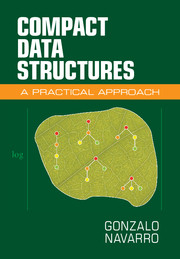1 - Introduction
Published online by Cambridge University Press: 05 September 2016
Summary
Why Compact Data Structures?
Google's stated mission, “to organize the world's information and make it universally accessible and useful,” could not better capture the immense ambition of modern society for gathering all kinds of data and putting them to use to improve our lives. We are collecting not only huge amounts of data from the physical world (astronomical, climatological, geographical, biological), but also human-generated data (voice, pictures, music, video, books, news, Web contents, emails, blogs, tweets) and society-based behavioral data (markets, shopping, traffic, clicks, Web navigation, likes, friendship networks).
Our hunger for more and more information is flooding our lives with data. Technology is improving and our ability to store data is growing fast, but the data we are collecting also grow fast – in many cases faster than our storage capacities. While our ability to store the data in secondary or perhaps tertiary storage does not yet seem to be compromised, performing the desired processing of these data in the main memory of computers is becoming more and more difficult. Since accessing a datum in main memory is about 105 times faster than on disk, operating in main memory is crucial for carrying out many data-processing applications.
In many cases, the problem is not so much the size of the actual data, but that of the data structures that must be built on the data in order to efficiently carry out the desired processing or queries. In some cases the data structures are one or two orders of magnitude larger than the data! For example, the DNA of a human genome, of about 3.3 billion bases, requires slightly less than 800 megabytes if we use only 2 bits per base (A, C, G, T), which fits in the main memory of any desktop PC. However, the suffix tree, a powerful data structure used to efficiently perform sequence analysis on the genome, requires at least 10 bytes per base, that is, more than 30 gigabytes.
The main techniques to cope with the growing size of data over recent years can be classified into three families:
Efficient secondary-memory algorithms. While accessing a random datum from disk is comparatively very slow, subsequent data are read much faster, only 100 times slower than from main memory. Therefore, algorithms that minimize the random accesses to the data can perform reasonably well on disk.
Information
- Type
- Chapter
- Information
- Compact Data StructuresA Practical Approach, pp. 1 - 13Publisher: Cambridge University PressPrint publication year: 2016
